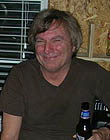|
Author
|
Topic: Solar Cell Preamplifier Design Problem
|
Marin Zorica
Jedi Master Film Handler

Posts: 671
From: Biograd na Moru, Croatia
Registered: May 2003
|
 posted 11-28-2005 03:30 PM
posted 11-28-2005 03:30 PM




I work on preamp design and now i got something new, but don't working like i was planned :-) , maybe somebody know answer.
This is schematic of it:

OK, When photodiode is decoupled from preamp with capacitor everything is ok, but when i conected it directly i don't get sound like it should be, i got it but like the wire losing contact or have poor contact, but everything is OK with contact, but is sounding like that (don't know how different i described that sound), and when i put capacitor in serial with photodiode i got ok sound and everything working fine.
I use some polish photodiode 1PP75, because i have it in mine projector sound head in the moment, but that's not problem i think!!
Can you figure what could be problem of this? Did you ever have problem like this?
I also try to change polarity of photodiode but then i got no sound at all, or some poor sound but with same effect.
Tnx!
| IP: Logged
|
|
|
|
|
|
|
|
|
|
|
|
|
|
|
|
|
|
|
|
|
|
|
|
|
|
|
|
|
|

 Home
Home
 Products
Products
 Store
Store
 Forum
Forum
 Warehouse
Warehouse
 Contact Us
Contact Us




 Printer-friendly view of this topic
Printer-friendly view of this topic










![[Wink]](wink.gif)

![[beer]](graemlins/beer.gif)

![[Smile]](smile.gif)



